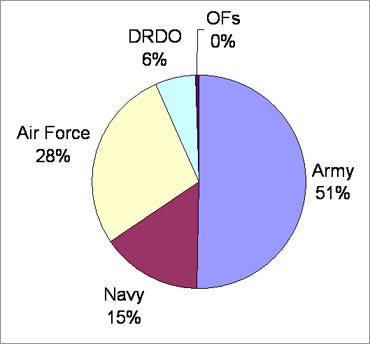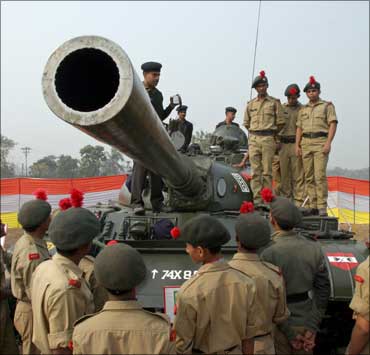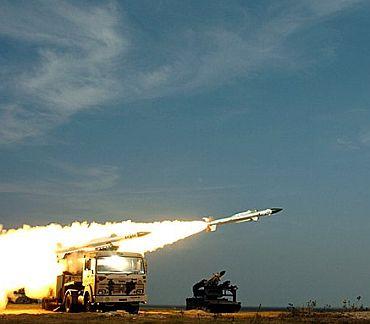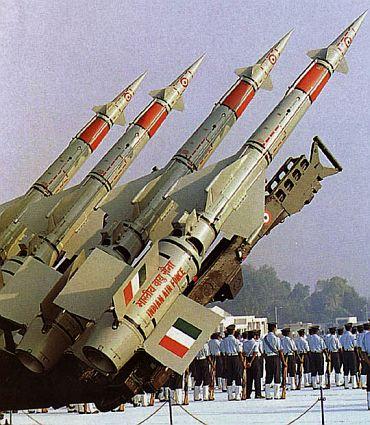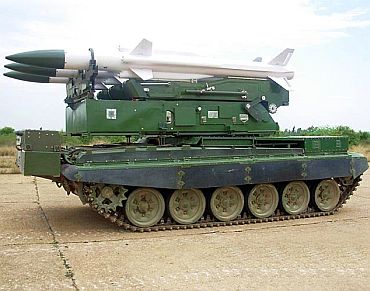 | « Back to article | Print this article |
Why India needs to spend more on its defence
In his Budget Speech on February 28, 2011, Finance Minister Pranab Mukherjee set aside Rs 164,425 crore ($36 billion) for defence during the next financial year (FY 2011-12).
This is less than 2 per cent of the country's GDP despite the recommendations of successive Standing Committees on Defence in India's Parliament that it should be at least 3 per cent if the emerging threats and challenges are to successfully countered.
Meanwhile, China has increased its official defence expenditure for 2011 by 13 per cent to $91.5 billion, while its actual expenditure on defence is likely to be close to $150 billion (3.5 per cent of its GDP).
The United States' defence expenditure in the fiscal year 2010 was $530 billion, excluding funds allotted for the wars in Afghanistan and Iraq.
Click NEXT to read on . . .
Why India needs to spend more on its defence
Of the total allocation for defence, on the revenue account the Army will get Rs 64,250 crore (Rs 642.50 billion), the Navy Rs 10,590 crore (Rs 105.90 billion), the Air Force Rs 159,300 crore (Rs 159.30 billion) and the Defence Research and Development Organisation Rs 5,624 crore (Rs 56.24 billion).
The total revenue expenditure planned for the year is Rs 95,216 crore (58 per cent of the budget).
The remaining amount of Rs 69,199 crore (13.75 per cent increase, 42 per cent of the budget) has been allotted on the capital account for the acquisition of modern weapon systems, including 126 multi-mission, medium-range combat aircraft, C-17 Globemaster heavy lift aircraft, 197 light helicopters, 145 ultra-light Howitzers and C-17 heavy-lift aircraft.
Click NEXT to read on . . .
Why India needs to spend more on its defence
It is well known that India plans to spend approximately $100 billion over the next 10 years on defence modernisation.
Giving his reaction to Finance Minister Pranab Mukherjee's Budget Speech, Defence Minister A K Antony said, "We welcome it as our concerns have been by and large addressed and the finance minister has stated that if we have any fresh requirements, they would be made up without any difficulty."
However, while the reactions of the armed forces are not known, they are unlikely to be satisfied as their plans for modernisation have been stymied year after year by the lack of committed budgetary support.
The 11th Defence Plan, which will enter its fifth and final year on April 1, has not yet been accorded approval in principle by the government and, therefore, lacks committed budgetary support.
The only silver lining on the horizon is that the funds earmarked on the capital account for FY 2010-11 have been fully spent by the government for the first time in many years.
Click NEXT to read on . . .
Why India needs to spend more on its defence
In addition to the defence budget, the government has also earmarked adequate resources in the annual budget of the ministry of home affairs for homeland or internal security.
A portion of these funds will be utilised for setting up a National Intelligence Grid and the National Counter-terrorism Centre -- measures which are considered necessary consequent to the Mumbai terror strikes in November 2008.
Also, funds for the modernisation of central police and para-military forces will be provided from the budget of the MHA.
This year's defence budget is 1.83 per cent of the projected GDP and 13.07 per cent of the total central government expenditure.
In fact, according to the recommendations made by the 13th Finance Commission, the nation's defence expenditure should progressively come down to 1.76 per cent of the GDP by 2014-15. Quite clearly the finance ministry appears to have decided to pay heed to this advice.
Comparison: Defence Budget 2010-11 and 2011-12
| 2010-11 | 2011-12 | |
| Defence Budget (Rs in Crore) | 147,344 | 164,415.49 |
| Growth of Defence Budget (%) | 3.98 | 11.59 |
| Revenue Expenditure (Rs in Crore) | 87,344 | 95,216.68 |
| Growth of Revenue Expenditure (%) | 0.57 | 9.01 |
| Share of Revenue Expenditure in Defence Budget (%) | 59.28 | 57.91 |
| Capital Expenditure (Rs in Crore) | 60,000 | 69,198.81 |
| Growth of Capital Expenditure (%) | 9.44 | 15.33 |
| Share of Capital Expenditure in Defence Budget (%) | 40.72 | 42.09 |
| Share of Defence Budget in GDP (%) | 2.12 | 1.83 |
| Share of Defence Budget in Central Government Expenditure (%) | 13.29 | 13.07 |
(Source: Laxman Behera, IDSA)
Click NEXT to read on . . .
Why India needs to spend more on its defence
While the defence budget as a percentage of the GDP is certainly only one among many internationally acceptable indicators of a country's defence expenditure, no matter which yardstick India's defence budget is measured by, it is seen to be well below international norms.
India's per capita expenditure on defence is less than $10, while the average expenditure of the top ten spenders in Asia is $800 approximately.
At 1.22/1,000 citizens, India's soldiers-to-citizens ratio is also among the lowest in Asia. The average of the top ten Asian nations is about 20/1,000 (China 1.76/1,000).
Although the present allocation shows an increase of 11.59 per cent over the budgetary estimates for FY 2010-11 and 8.47 per cent over the revised estimates, it is barely adequate to neutralise the annual rate of inflation.
Year-on-year inflation is averaging over 11 per cent and shows no sign of abating in the short term. Hence, in 'real', inflation-adjusted terms, the defence budget has been declining and not increasing in recent years.
Click NEXT to read on . . .
Why India needs to spend more on its defence
Also, inflation in weapons, ammunition and defence equipment is usually much higher than domestic inflation. For example, the MiG-21 costs $1 million but its replacement fighter aircraft like the F-18 and the Eurofighter will cost over $100 million each.
Finally, the most relevant yardstick for measuring the adequacy of defence expenditure is whether or not India is getting the defensive capabilities that it needs.
In view of the continuing territorial disputes with China and Pakistan and the increasing nuclear, missile and military hardware nexus between them -- prompting the need to prepare for a two-front future war, the emerging threats and challenges on the strategic horizon, especially on the maritime security front, the lack of military modernisation and the marked obsolescence of the weapons and equipment of the armed forces, India is consistently failing to develop the capabilities that its armed forces will need in the 2015-20 timeframe.
Therefore, the country needs to spend much more on its defence if another military debacle like that of 1962 is to be avoided.
This is one field in which complacency costs lives and imposes unacceptable burdens during future crisis situations.
Gurmeet Kanwal is Director, Centre for Land Warfare Studies (CLAWS), New Delhi.

